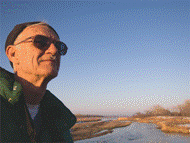Papers in the Biological Sciences

Paul Johnsgard Collection
Document Type
Article
Date of this Version
10-1960
Abstract
Although the" courtship" behaviour of waterfowl has attracted widespread interest and has been the subject of several major papers (e.g. Heinroth 1911, Lorenz 1951-1953), the actual means by which pairs are formed in most species of waterfowl remains unknown. We may conclude by inference that the females of most species of ducks must actively "select" their mates, for the elaborate male displays and plumage patterns present in the group can only be reconciled in terms of sexual selection. In addition, any observer of waterfowl will soon realize that it is the males which actively " court" the females, and that the females often behave in a passive or even antagonistic fashion towards them.
Since males of different species of related waterfowl have different plumages and different combinations and elaborations of homologous display patterns (Lorenz 1951- 1953), it appears that these plumages and displays function both as species-specific signals which tend to prevent hybridization (Sibley 1957), and as the probable basis for individual mate selection by females (see Johnsgard 1960). And yet, during actual instances of courtship when all the unmated males repeatedly perform the same displays towards the available females it is often hard to conceive the means by which mate selection actually operates. One must hypothesize that on the basis of minor differences in display and/or plumage characteristics a certain male is singled out by the female from the potential mates and is somehow" notified" of her choice. However, most display descriptions stress male, rather than female, signals, no doubt because they are the more conspicuous and elaborate. Since the mechanism of mate selection is of fundamental importance in terms of isolating mechanisms and sexual selection, I have given some attention to this problem as it concerns the waterfowl group with which I am most familiar, namely, the Anatinae and, in particular, the genus Anas.


Comments
Published in THE IBIS 102:4 (October 1960), pp. 616-618.
Published by the British Ornithologists' Union.